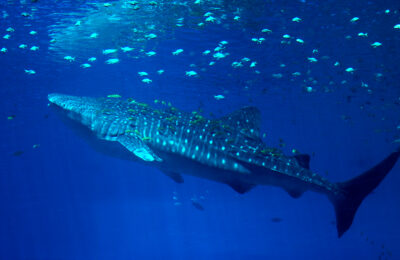Article: Reed, Daniel, et al. “Extreme warming challenges sentinel status of kelp forests as indicators of climate change.” Nature Communications 7 (2016).
Background:

Studying the effects of climate change can be difficult. It’s hard to recreate ecological systems, the network of species interactions, and the variance of environmental conditions within a lab setting. Likewise, modeling the effects of climate change comes with varying degrees of precision. As such, scientists are often looking for the canary in the coal mine, or a sentinel species that can act as an early warning indicator of climate change. There have been numerous studies that show kelp species are sensitive to changes in ocean temperature and in nutrient levels. Their sensitivity, coupled with their rapid growth, seem to make kelps ideal sentinel species (Fig. 1). In addition, kelps play a critical role in providing habitat and food for a wide range of marine creatures, so their sensitivity to climate would be important in determining the impact on entire ecosystems.

Just a few years ago, the waters off the Pacific coast of North America began to warm. Temperatures were as much as 3 degrees Celsius warmer than had been observed since the 1980s. Higher atmospheric pressure meant that oceans held onto their heat a little longer and decreased winds prevented cooler deeper water from upwelling. All of this resulted in a large mass of warm water, affectionately called “The Blob” by scientists, that sat off the coast starting in 2014 (Fig. 2). Followed by El Nino, waters off the California coast remained warm through 2015. In addition, the lack of upwelling along the coast reduced the amount of nutrients available for kelp. This long spell of warmer-than-usual ocean water and low nutrient conditions provided an opportunity for scientists to investigate how marine communities, specifically kelp communities were affected. If there was evidence of an impact of warmer, nutrient poor water on kelp then we may very well use it as a sentinel species.
The Study:
The coast of southern California has kelp forest that have been studied for a long time. Relatively permanent plots within forests of giant kelp, Macrocystis pyrifera (Fig. 3), have been monitored for a number of years. By comparing the biomass and cover of Macrocystis between previous years and “Blob years,” scientists could determine whether this prolonged period of warm, low nutrient water was causing problems for kelp forest ecosystems.


Researchers did find a decline in the cover of giant kelp in southern California during the blob years. However, compared with trends over a 15-year period, the scientists showed that the kelp decline observed in the warmer years was actually just part of a larger trend in kelp decline — the decrease in coverage was not necessarily linked to the change in ocean condition (Fig. 4). In addition, surveys of other kelp forest associated creatures showed similar declines (Fig. 5). Similarly, the canopy biomass of kelp during blob years was variable, and didn’t stray far from previous estimates of biomass (Fig. 6).


The Significance:
The Blob provided a unique opportunity to study longer term impacts of climate change on important marine species and communities in a natural setting. Kelp species were thought to be sensitive and vulnerable to warmer waters and low nutrient concentrations, but results of this study show that despite a decline, the kelp cover and biomass fit a larger trend that is independent of prolonged warming. This shows that giant kelps are potentially more resistant to global climate change than previously thought. As such, it wouldn’t make sense to classify kelps as sentinel species. The lack of a clear response to the Blob highlights an inability to act as an early warning or an indicator. This does not mean, however, that climate change will not negatively impact these species and ecosystems, rather, it shows that we should be careful when trying to predict the impacts of change and the dangers in establishing sentinel species.
Postdoctoral Researcher, Claremont McKenna College
I am currently a postdoc at Keck Sciences, Claremont McKenna College. I work with Dr. Sarah Gilman, measuring and modeling energy budgets in intertidal species. I am a climate scientist and marine community ecologist and my PhD (University of Rhode Island) focused on how ocean acidification and eutrophication, alters coastal trophic interactions and species assemblages.
I love bad jokes and good beer.

